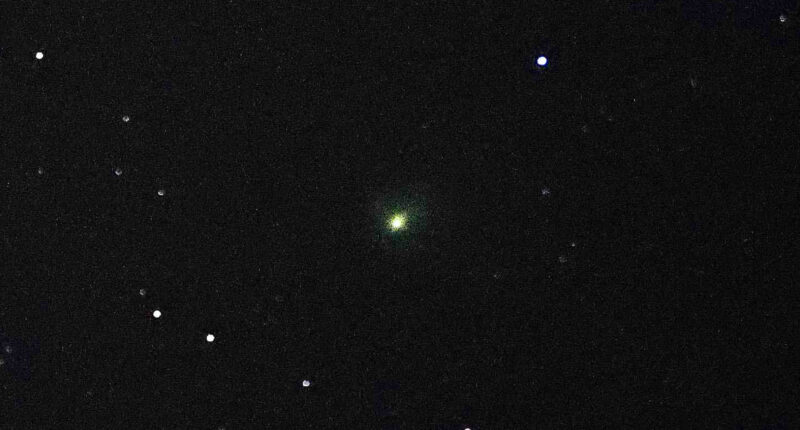
A GREEN comet that was recently identified will be visible from Earth tonight for the first time in 50,000 years.
The Stone Age was the last time it was visible in the night sky.
The once-in-a-lifetime comet was found on March 2, 2022, by astronomers using the wide-field survey camera of the Zwicky Transient Facility at the Palomar Observatory in San Diego County, California.
The name of the comet refers to its blazing green tail, which is caused by a chemical reaction between the comet’s diatomic carbon molecules (C2) and ultraviolet radiation from the sun.
The comet will reach its zenith in the sky at about 9.45pm on February 2 above the northern horizon, according to the astronomy blog In the Sky.
Shortly after dusk, it’s meant to initially appear, and just before 6am, it will vanish.
Follow our Green Comet 2023 blog for news and updates
-
Other notable comets in history: The Great Comet of 1680
The comet was discovered on Nov. 14, 1680, by German astronomer Gottfried Kirsch.
What makes this comet special is it was the first comet discovered by a telescope.
It was reported from Albany, N.Y. that the comet could be seen in daylight passing above the sun.
The comet was deemed not visible to the naked eye by early February 1681.
-
Comets have a relationship with the sun
Halley, a comet, travels at a distance from the sun of 89million kilometers, which is a safe distance for most comets, reports Nasa.
But some comets, known as sungrazers, collide with the sun head-on or approach it so closely that they fragment and vanish.
-
View the green comet livestream
The Cosmosapiens Youtube channel is hosting a live stream of the Green Comet’s arrival.
The caption below the video reads, “Green Comet also known as C/2022 E3 is getting brighter to become 2023 the best comet to watch live. Don’t miss this unique celestial event.”
This is the first time the comet is passing Earth in 50,000 years.
The last time the Green Comet was visible from Earth was when Neanderthals and early Homo sapiens roamed the planet.
-
Hopeful individuals flock to Twitter to discuss the arrival of the green comet
Many Twitter users have shared their thoughts and plans for the arrival of the ‘once in a lifetime’ comet.
One user wrote, “I’m going to cry looking at the Green Comet”
Another wrote, “really want to go stargazing for the green comet right now it was last visible during the stone age”
A third wrote, “On my way to Tybee Isl. with my parents’ handy dandy telescope to look for the green comet tonight”
-
How comets get named
It might be challenging to name comets, according to Nasa. In most cases, comets are named after the person or spacecraft that discovered them.
Only in the past century was this International Astronomical Union recommendation produced.
For instance, comet Shoemaker-Levy 9 was given that name because Eugene and Carolyn Shoemaker and David Levy discovered it as their ninth short-period comet.
Many comets include LINEAR, SOHO, or WISE in their names because spacecraft are particularly good at finding them.
-
Meet C/2022 E3
The comet was found on March 2, 2022, by astronomers using the wide-field survey camera of the Zwicky Transient Facility at the Palomar Observatory in San Diego County, California.
The comet was closest to the sun on January 12, Nasa reported.
According to The Planetary Society, the comet with the designation C/2022 E3 (ZTF), per Nasa, has an orbit around the sun that travels through the outer regions of the solar system, which explains why it has taken so long for it to pass by Earth once more.
-
Experts predict comet’s next move
Researchers at the Zwicky Transient Facility, part of the California Institute of Technology’s Palomar Observatory, spotted the comet when it just inside Jupiter’s orbit – around 399million miles away from the Sun.
Scientists expect the comet to pull away from Earth and zoom back into deep space after making its closest swoop toward our planet at the beginning this month.
-
Experts predict comet’s next move
Researchers at the Zwicky Transient Facility, part of the California Institute of Technology’s Palomar Observatory, spotted the comet when it just inside Jupiter’s orbit – around 399million miles away from the Sun.
Scientists expect the comet to pull away from Earth and zoom back into deep space after making its closest swoop toward our planet at the beginning this month.
-
Comas, explained
The comet’s “coma” is the vast and incredibly thin atmosphere created by the jets of gas and dust that are so expelled.
A gigantic “tail” that points away from the sun develops as a result of the solar wind and radiation pressure of the sun acting on the coma.
Water makes up to 90 percent of the volatiles that escapes from the comet’s nucleus when it is within 3 to 4 astronomical units of the sun, making up the majority of the coma’s composition.
-
Optimal viewing recommendations
Observers will be able to see the comet as a dim green smudge close to the bright star Polaris, popularly known as the North Star, as it approaches Earth.
Due to their chemistry and present places in orbit, comets reflect light in a variety of colors.
The best time to watch the comet is in the early morning hours after the moon has set for those in the Northern Hemisphere after midnight, CNN reports.
For people in the Southern Hemisphere, it will be more challenging to see the space object.
Using binoculars or a telescope will make it easier to observe C/2022 E3 (ZTF), while it may be visible to the unaided eye in the dark depending on its brightness, per the outlet.
-
Easily distinguishable
The comet’s streaking tails of dust and charged particles, as well as the brilliant green coma that surrounds it, can be used to tell it apart from the stars, according to CNN.
As a comet approaches the sun, a coma builds around it, causing its ice to sublimate, or transform instantly into gas.
When viewed through a telescope, the comet appears hazy as a result.
-
If clouds get in the way of viewing parties
The Virtual Telescope Project will webcast a live feed of the comet in the skies above Rome if clouds or bad weather prevent skywatching.
But photos from the James Webb Space Telescope will not be a possibility.
The Telescope will be keeping an eye on the green comet, but it won’t be taking any pictures, Nicolas Biver, an astrophysicist at the Paris Observatory told France 24.
-
What happens when a comet gets too close to the sun
When a comet gets close to the Sun, some of the ice starts to melt and boil off, along with particles of dust, according to nineplanets.org.
These particles and gases make a cloud around the nucleus, called a coma, which can extend between hundreds to thousands of km.
The nucleus is the solid core structure of a comet, no larger than a few km, and it is composed out of rock, dust, water ice, and frozen carbon dioxide, monoxide, methane, and ammonia.
-
What affects the brightness of a comet?
There are many different factors that affect the brightness of a comet.
According to Nasa, “how bright a comet appears depends both on what we can predict, how close it is to the Earth and how close it is to the Sun, and on what we cannot predict, how much gas and dust it is giving off.”
-
Comets were perceived as ‘terrifying’
Comets are beautiful to look at through a telescope or binoculars in the dark night sky but they weren’t always perceived that way.
In the distant past, they were perceived as terrifying up until the 16th century.
Comets were often considered bad omens such as the death of kings, coming catastrophes, or even interpreted as attacks by heavenly beings.
-
Some comet facts, part V
Planets sometimes travel through a comet’s tail which causes what’s known as meteor showers, according to nineplanets.org.
Most meteor showers on Earth are caused by comets, such as the Quadrantids, Lyrids, Perseids, Orionids, Leonids, or Geminids meteor showers.
-
Some comet facts, part IV
Comets will occasionally crash into one another thus changing their direction, and throwing them out toward the inner solar system, nineplanets.org reported.
When a comet approaches the inner planets, it is warmed by the Sun.
It begins to melt and throws out dust and gas creating a head and a tail.
The tail always points away from the Sun and the head points towards it.
-
Some comet facts, part III
The Oort Cloud and the Kuiper Belt are way out in the Solar System, very far away from the Sun, according to nineplanets.org.
To this very day, the Oort Cloud hasn’t even been directly observed.
A comet spends the majority of its life in either the Kuiper Belt or the Oort Cloud.
-
Some Comet facts continued
Like asteroids, comets are leftovers from the formation of the Solar System.
Many Scientists believe that these small bodies can hold many clues as to how our Solar System came to be.
Comets come from what is known as the Kuiper Belt and the Oort Cloud, nineplanets.org reports.
-
Some Comet facts
Comets, unlike other small bodies in the Solar System, have been known since before the Middle Ages according to nineplanets.org.
Ancient Chinese astronomers used to keep extensive records and illustrations about comets that have contributed to modern astronomers’ studies and observations.
The word “comet” comes from the Greek word “Kometes” which translates to long hair. This is because of how a comet’s tail can look like long flowing locks of hair.
-
Twitter users comment on the Green Comet
Hopefuls planning on seeing the comet have taken to Twitter to talk about the historic event 50,000 years in the making.
One user wrote, “I will try to see the green comet again, I will get up at 4:00 am to at least record something gshs and so I can say that I was one of those who saw it”
Another wrote, “Looking up at the night sky has always amazed me. Bearing witness to this #greencomet that hasn’t been seen in 50,000 years is wild & magical. If certain factors were different it could smash into Earth, but it’s not. It’s staying up there. What a time to be alive”
-
What comets are
A comet is a tiny, frozen body in the Solar System that warms up and starts to emit gases as it approaches the Sun.
This process is known as outgassing. This results in an apparent atmosphere or coma, and occasionally a tail as well.
These occurrences are caused by how the solar wind and solar radiation interact with the comet’s nucleus.
The size of comet nuclei varies between a few hundred meters and tens of kilometers, and they are made up of loose clumps of ice, dust, and tiny rocky particles.
The tail may extend beyond one astronomical unit, and the coma may be up to 15 times the diameter of the Earth.
Since the beginning of time, numerous cultures and religions have witnessed and documented comets.
-
What comets are made up of
The main components of comets include dust, ice, and gases.
However, determining the precise material makeup of the comet can aid researchers in learning more about the formation of our solar system.
The comet’s layers disintegrate under the Sun’s heat, making it easier for scientists to investigate its composition the closer it travels to the sun.
-
What comets are made up of
The main components of comets include dust, ice, and gases.
However, determining the precise material makeup of the comet can aid researchers in learning more about the formation of our solar system.
The comet’s layers disintegrate under the Sun’s heat, making it easier for scientists to investigate its composition the closer it travels to the sun.
-
Scientists studying what comet is made out of
The James Webb Space Telescope will be keeping an eye on the green comet, but it won’t be taking any pictures, Nicolas Biver, an astrophysicist at the Paris Observatory told France 24.
The $10billion telescope will instead look at what exactly the comet is made up of.
Comets are mostly made up of dust, ice and gases.
But figuring out the comet’s exact material composition can help scientists uncover more about how our solar system came to exist.
This post first appeared on Thesun.co.uk









